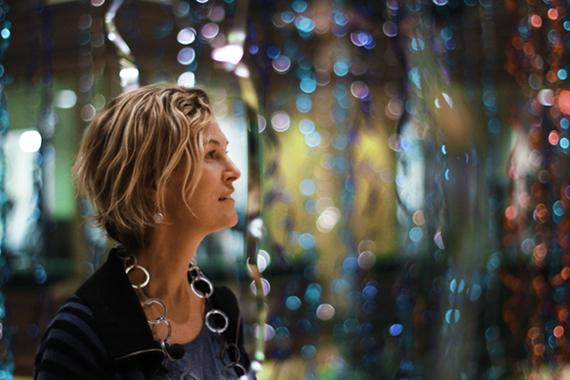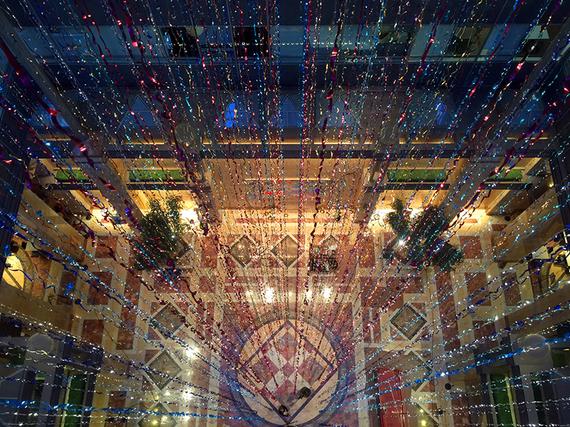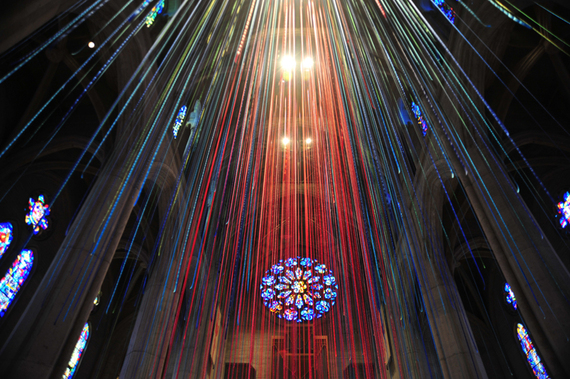Anne Patterson and I stepped into the darkened former Perry Street Theater. "Does your iPhone have a flashlight?" she asked. "Wait until you see the light and shadows," Anne beamed. She waved the point of light against one of her latest works, constructed of aluminum and steel. Light filtered through the aluminum wires, casting a hypnotic play of shadow and light upon the wall. Across the room, dangling satin ribbons gracefully cascaded to the floor. Patterson's whimsical works enliven the timeworn theater, now home to architects and artists. Trained as a stage designer, Anne Patterson creates mesmerizing installations, magical scenic designs, lush watercolors and arresting sculptures that are influenced by synesthesia-inducing colors.
Patterson, who is based in Manhattan's West Village, has synesthesia, a neurological condition in which the stimulation of one sense causes an involuntary response in another sense. People with synesthesia, known as synesthetes, often associate numbers and letters with colors, and sounds with shapes and textures. When Patterson listens intently to music, particularly classical strings, her mind produces distinctive shapes and colors in response to the sounds. "I see an incredible magnificence of colors and shapes when I hear music," Anne says. "The smells of spring trigger a play of light in my mind and my primary numbers have personalities." Patterson's artwork is directly influenced by this peculiar neurological condition. "I strive to create work that transports us into a multi-sensory realm, similar to that which I've inhabited for my entire life, and deepens our relationship to the beauty around us."
Synesthesia, a harmless condition, takes many forms. Most commonly, synesthetes will associate a specific number, letter or unit of time with a particular color or personality. Music can produce distinctive, colorful shapes in the mind's eye. A rare form of synesthesia, known as lexical-gustatory synesthesia, causes people to smell and taste colors, shapes, or textures. The wide-ranging effects of synesthesia are not limited to these symptoms, as each synesthete experiences the sensations uniquely.
Patterson is not the first artist to mirror the effects of synesthesia. Wassily Kandinsky (1866-1944), known for his radical abstract paintings, sensed the vibration of colors on his canvases. Novelist Vladimir Nabokov (1899-1977) described his experience of "colored hearing" in Speak, Memory: "The long a of the English alphabet...has for me the tint of weathered wood, but the French a evokes polished ebony."
"Colored hearing" has proven to be a major influence for Patterson. "My mission is to see music, to feel color," she explains. "When I look at leaves and trees, I hear the sounds they're making. My goal is to make the audience experience music and art on another level, an integration of two worlds." Patterson's reverence for nature, with its visual and aural stimuli, colors her diverse oeuvre.
"The Light Between", Patterson's current major installation, is displayed in the lobby of a high rise building in Boston.
"The motion of ribbons dropping through the air was the inspiration for this installation," Anne articulates. "Constructed out of aluminum, the metal ribbons magnify the natural light from the windows of 125 High Street, dispersing its energy through the man-made space."
This enchanting phenomenon stimulates the viewer into a whirl of euphoria.
"Graced With Light - The Ribbon Project" (March 2013 - January 2015), a music inspired installation, was displayed in Grace Cathedral, San Francisco. "Graced With Light" featured 20 miles of multi-colored satin ribbons hanging from the cathedral's vaulted ceiling.
"The satin side of the ribbons catch the light in such a way that it looks like electricity," Anne explained. "There is this incredible experience where it feels like the light is streaming down into you, and, in turn, your energy is streaming out and up the ribbons. There is a sense of connecting heaven and earth."
Patterson, who holds a B.A. in Architecture from Yale University and an M.F.A. in Theater Design from The Slade School of Art in London, has designed installations for orchestras such as San Francisco Symphony and Philadelphia Orchestra. She has also designed sets for productions at the Arena Stage in Washington D.C and the Wilma Theater in Philadelphia. The artist's unique phenomenological response to the musical composition determines her design for the set. "Sculpture, scenery, lighting, costume, and projections combine to create installations that are a visual response to the music," she explains. Her paintings and sculptures are in private, public, and corporate collections across the USA and in London. She was awarded a Creative Capital Grant from the Warhol Foundation, is a fellow of the Hermitage Artist's Retreat, and has been a visiting professor at Carnegie Mellon University.
Patterson's latest foray, working with gold, has fashioned breathtaking results, such as the dazzling sculpture "All That Glitters is Not Gold". Her multimedia works invite us to look, listen and wonder -- whether it is an operatic visual or the delicate touch of a playful ribbon, Anne Patterson's artwork is a magical sensory experience. Patterson turned to me and mused, "Doesn't 'The Barber of Seville' seem orange to you?"



